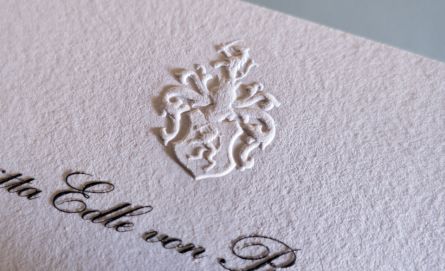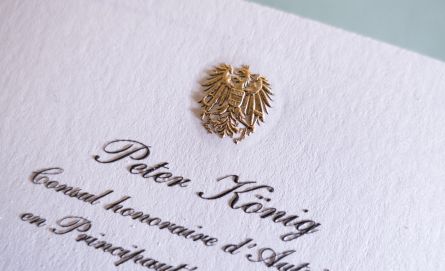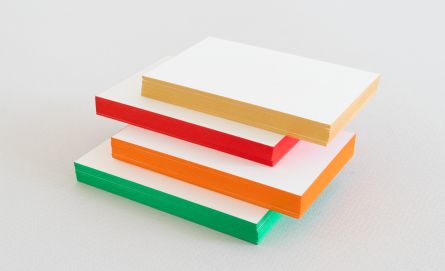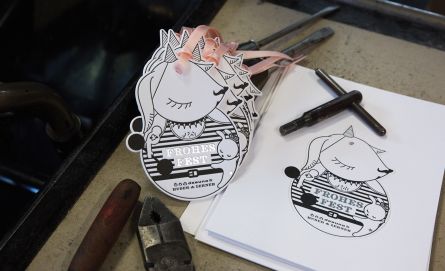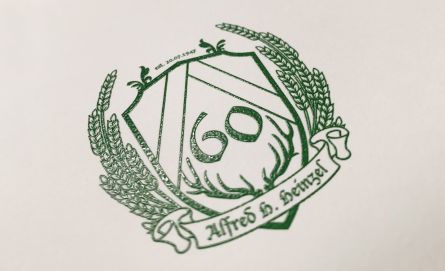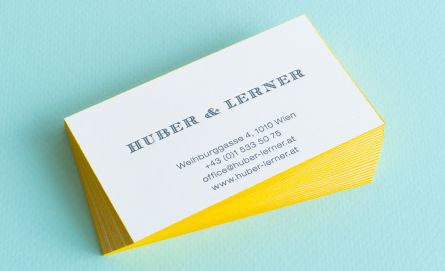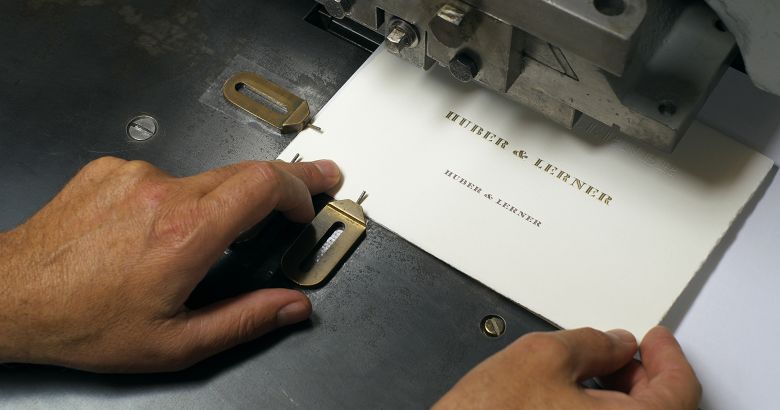
Printing Techniques
We offer a multitude of different printing methods and techniques, allowing the combining of the most wonderful, ultra-modern technology with traditional craftsmanship. Our stationery gets its reputation from our printing precision and timeless, elegant design.
We produce all types of stationery in the ever-loved and high-quality form of offset printing. We also offer a multitude of special printing technologies and finishing techniques, in addition to this classic printing form:
Relief-printing or thermography is a finishing process that is used in combination with classic offset printing. The printed text is not only give extra gloss but can also be felt by the fingers. This process is excellent for logos, coats of arms and cards.
Our premium product is stamp embossing in colour and as blind embossing and is an expression of high-quality craftsmanship created not only for aesthetic purposes but as a haptic experience. Stamp embossing reflects high personal expectations in terms of quality and processing, as well as timeless elegance and understatement. Company logos and family coats of arms can be created perfectly using this technique. This method is ideal for business cards, writing paper, correspondence cards, and envelopes. Straight and to the point: first impressions count!
Foil embossing is one of the printing methods that stands out from other techniques due to its optical shine.
Letterpress printing or book printing has been experiencing somewhat of a Renaissance at the moment and creates a special haptic feeling partly due to the actual printing and partly due to the heavy, structured paper it uses. The layouts and designs reflect today’s zeitgeist with their retro charm. A return to craftsmanship and quality.
Huber & Lerner’s range of special finishing methods can give a stylish printed product extra character. These include round edges, plate impressions, and punching and perforations, as well as colour cutting, preferably in gold, which has a stunning effect on exclusive paper with a heavier weight. It is possible to combine different printing process with each other – for example, a stamp embossed name with dates printed using the offset method.
Offset Printing
Classic offset printing is still the dominant method, despite the development of new technologies and has provided high quality and customer satisfaction for years. This is an indirect printing process, created through the chemical repulsion behaviour of oil and water. The printing points on the printing plate are oily and repulse water when moistened and consequently absorb the ink that is placed on a rubber blanket and which is then transferred to the paper.
Thermo-Relief or Thermographic Printing
Thermo-relief or thermographic printing is a finishing method that can be combined with offset printing. Lines and smaller surfaces become more raised and easier to touch with thermography. This process involves the melting of heat-sensitive granules on the heated printing sheet together with the still damp offset printing ink. The printed text is then made easier to touch with a transparent, plastic coating. This process is a less costly alternative to stamp embossing.
Stamp Embossing
The most exclusive of all printing methods, stamp embossing has a long tradition at Huber & Lerner. The Imperial family used this service. Many years of experience and expert know-how are what is needed to provide the craftsmanship and pedigree effect for the perfect execution of lettering, coats of arms, and company logos. Stamp embossing can be in the form of colour embossing or blind embossing. It is often the case that colour embossing is combined with blind embossing and heated foil embossing, as well as normal printing. The art of printing coats of arms is a very special tradition at Huber & Lerner. The producing of such heraldic designs or company logos needs careful planning, so that the art of stamp embossing and its effect are truly perfect. This requires many years of experience and specialist know-how. It is the embosser who decides the quality of the product. Stamp embossing is considered the most exclusive printing method as the result of its unrivalled engraving technique, expressing a personal lifestyle.
Blind Embossing
Blind embossing results in a special haptic experience similar to stamp embossing in terms of its colour. Blind embossing gives an extraordinary impression due to its simple elegance and is perfect for cards with coats of arms or logos.
Hot Foil Stamping or Foil Embossing
Foil embossing or stamping is similar to colour or blind embossing and creates a shiny, metal effect on coloured foil placed on the printing materials, which cannot be achieved using other processes. This technique can be combined with relief embossing to produce an even better, top-class haptic experience.
Copper Plate Printing
A process developed in about 1400 and based on standard intaglio or gravure printmaking. The text or drawing is engraved into the polished surface of a copper plate using a fine chisel. Each individual letter is engraved into the copper plate with the chisel. The finished printing plate has to be covered in ink by hand before each print is made. Traditional copperplate embossing is craftsmanship in its finest form and creates a product of exquisite quality. This printing method is ideal for cards or invitations.
Letterpress Printing
When lead typesetting and letterpress printing were slowly replaced by photo typesetting and offset printing in the 1950s, no one expected these classic forms of what some consider the “dark arts” to see a later revival, especially in our digital age. Book and letterpress printing are considered as the original form of printing begun by Johann Gutenberg, which reproduces texts and images through the use of parts of raised letters and printing moulds. Lead letters have been used a print medium from the beginning, but also wooden letters and printing plates have been used in this process. Letterpress printing is the most traditional of all the printing processes in use. It gives all sorts of stationery a three-dimensional fullness, which is underpinned by the craftsmanship of the printer. It is possible to feel the letters in such as print work when you take into your hands and not just see them. This craftsmanship is one of the reasons why this is so fascinating. The palette of products made using letterpress printing ranges from greetings cards, writing paper and cards to wedding invitations and birth announcements. Letterpress printing is very versatile and the results give stationery a special form of aesthetics and personal note.
Color Cut Finishing (Letterpress only)
A special way of print finishing business cards, compliment cards or invitation cards is color cutting. This involves individually coloring the edges of the cards afterwards. This technique only uses very strong paper types with a high grammage of 600g and above. This is why only the classic letterpress printing process can be used for this type of paper finishing.
Lasercut Printing
The text or motif are engraved into the material in the paper on a layer-by-layer basis using a laser in this relatively new technique. This creates a three-dimensional image. Very delicate motifs are also possible, as are perforated ones.
